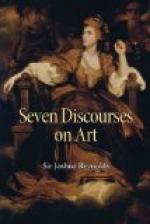Joshua Reynolds was born on the 15th of July, 1723, the son of a clergyman and schoolmaster, at Plympton in Devonshire. His bent for Art was clear and strong from his childhood. In 1741 at the age of nineteen, he began study, and studied for two yours in London under Thomas Hudson, a successful portrait painter. Then he went back to Devonshire and painted portraits, aided for some time in his education by attention to the work of William Gandy of Exeter. When twenty-six years old, in May, 1749, Reynolds was taken away by Captain Keppel to the Mediterranean, and brought into contact with the works of the great painters of Italy. He stayed two years in Rome, and in accordance with the principles afterwards laid down in these lectures, he refused, when in Rome, commissions for copying, and gave his mind to minute observation of the art of the great masters by whose works he was surrounded. He spent two months in Florence, six weeks in Venice, a few days in Bologna and Parma. “If,” he said, “I had never seen any of the fine works of Correggio, I should never, perhaps, have remarked in Nature the expression which I find in one of his pieces; or if I had remarked it, I might have thought it too difficult, or perhaps impossible to execute.”
In 1753 Reynolds came back to England, and stayed three months in Devonshire before setting up a studio in London, in St. Martin’s Lane, which was then an artists’ quarter. His success was rapid. In 1755 he had one hundred and twenty-five sitters. Samuel Johnson found in him his most congenial friend. He moved to Newport Street, and he built himself a studio—where there is now an auction room—at 47, Lincoln’s Inn Fields. There he remained for life.
In 1760 the artists opened, in a room lent by the Society of Arts, a free Exhibition for the sale of their works. This was continued the next year at Spring Gardens, with a charge of a shilling for admission. In 1765 they obtained a charter of incorporation, and in 1768 the King gave his support to the foundation of a Royal Academy of Arts by seceders from the preceding “Incorporated Society of Artists,” into which personal feelings had brought much division. It was to consist, like the French Academy, of forty members, and was to maintain Schools open to all students of good character who could give evidence that they had fully learnt the rudiments of Art. The foundation by the King dates from the 10th of December, 1768. The Schools were opened on the 2nd of January next following, and on that occasion Joshua Reynolds, who had been elected President—his age was then between forty-five and forty-six—gave the Inaugural Address which formed the first of these Seven Discourses. The other six were given by him, as President, at the next six annual meetings: and they were all shaped to form, when collected into a volume, a coherent body of good counsel upon the foundations of the painter’s art.
H. M.




